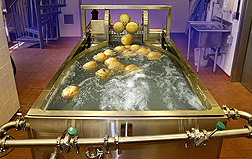Washing and Sanitizing Techniques Aim To Make Produce Safer
|
|
Fresh fruits and vegetables are rich in essential vitamins and minerals, a quality that contributes to healthier diets. But several outbreaks of food poisoning in recent years have been linked to cantaloupes, sprouts, lettuce, tomatoes, and other fresh produce. Conventional commercial washing and sanitizing methods to remove microbial contaminants from produce surfaces have been found to be marginally effective.
Scientists at ARS’s Eastern Regional Research Center (ERRC) in Wyndmoor, Pennsylvania, are conducting experiments to understand how these microorganisms survive and grow on produce surfaces even after exposure to sanitizing solutions like chlorine.
Says Bassam A. Annous, a microbiologist in ERRC’s Food Safety Intervention Technologies Research Unit, “Gaining knowledge of factors that permit survival of microbial contaminants during washing and sanitizing will help us develop new technologies for removing or inactivating microbes on both fresh and minimally processed produce.”
The human pathogen Salmonella is often the culprit behind produce-related outbreaks of foodborne illness. It’s an important concern in ensuring microbiological safety of fresh-cut cantaloupe. The bacteria quickly cling to the rind and form a “biofilm”—a mass of microbes attached to a surface and to each other by bacterial polymers (complex sugars). Then, Salmonella cells present on the rind can be transferred to the melon’s internal tissues during cutting.
Annous, along with postdoctoral researcher Ethan Solomon, biologist Angela Burke, food technologist Dike Ukuku, and biologist Peter Cooke, recently gained new insight into how Salmonella forms this biofilm on cantaloupe surfaces. Salmonella cells produce fimbriae (hairlike structures) and cellulose that help them attach, colonize, and survive on the melon’s surface. Once attached to the outside of the rind, the cells grow and excrete polymers, forming the biofilm, which shields the bacteria from harsh sanitizing solutions.
The researchers will collaborate with scientists at the University of Navarra, in Spain, to determine how Salmonella develop fimbriae as they grow and how they use them to cling to surfaces. They will also determine the role of specific bacterial polymers involved in surface attachment and biofilm formation by using Salmonella cells that are defective in producing fimbriae and/or cellulose.
But scientists are already finding ways to outsmart the bacterium. For instance, Annous and Joseph Sites, a mechanical engineer, recently developed a commercial-scale surface-pasteurization treatment that resulted in a 5-logs (99.999 percent) reduction in a population of Salmonella Poona on the surface of artificially contaminated cantaloupe. The process involves immersing melons in water at 169˚F for 3 minutes to kill the pathogens, then sealing each melon in a plastic bag before rapid cooling in an ice-water bath. The plastic bag prevents the fruit from potential recontamination in the cold water. The treatment not only enhances the safety of the fruit, but also extends its shelf life by reducing native microflora that may cause spoilage. And it did not harm melon quality.—By Jim Core, Agricultural Research Service Information Staff.
This research is part of Food Safety (Animal and Plant Products), an ARS National Program (#108) described on the World Wide Web at www.nps.ars.usda.gov.
Bassam A. Annous is in the USDA-ARS Food Safety Intervention Technologies Research Unit, 600 East Mermaid Ln., Wyndmoor, PA 19038-8598; phone (215) 233-6797, fax (215) 233-6406.
"Washing and Sanitizing Techniques Aim To Make Produce Safer" was published in the December 2005 issue of Agricultural Research magazine.







